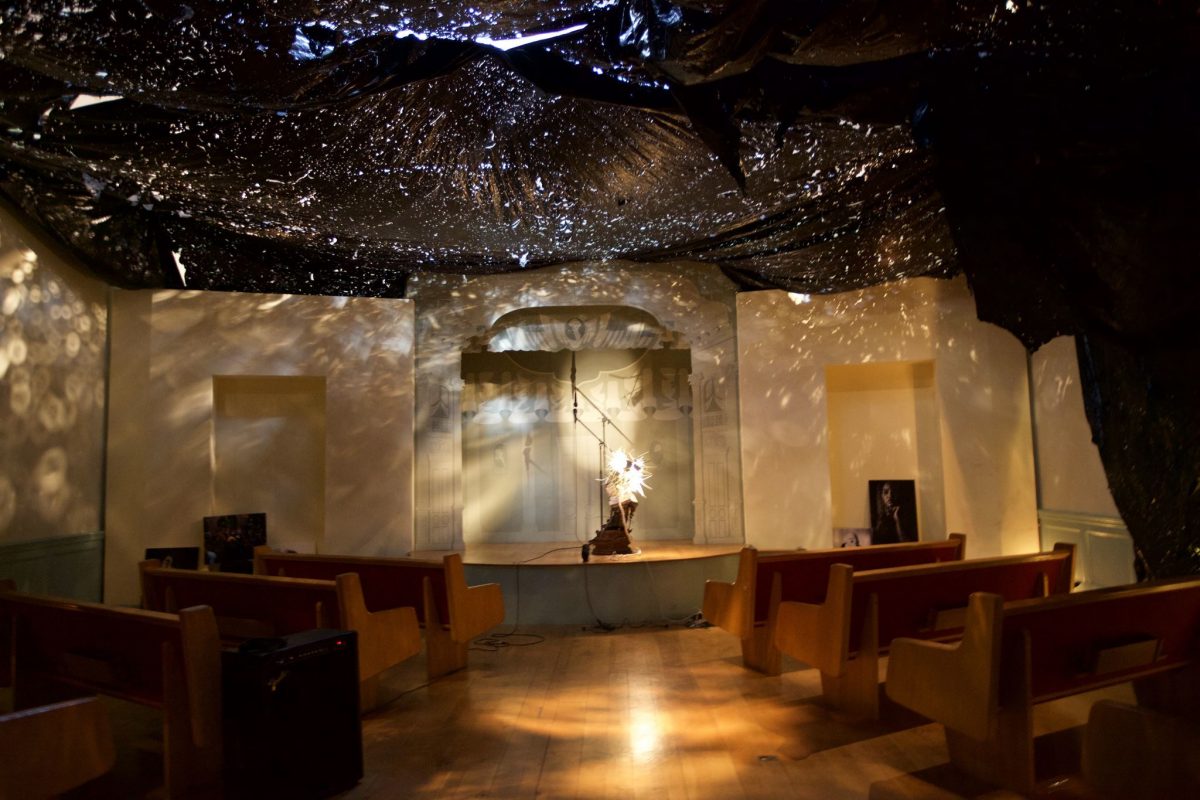
It’s nearly impossible to view “Only When It’s Dark Enough Can You See The Stars” and not feel challenged. It begins when you enter the lowly-lit first room at the Peale Museum, which houses this newest project from The Contemporary, and see the seated figure with its face comprised of light bulbs and broken glass, while the sounds of chalk on a blackboard screech in the background.
Perhaps you first view the figure, and the soles of shoes that dangle from a line above him, as jarring. But the more time you spend in the room, you start to notice details that give it depth. The seated being is wearing an Orioles hoodie—making it oddly familiar—and throughout the room are old photographs of African-American communities displayed on broken glass windows. Perhaps they’re reminding us that a way of life, and point in history, has been shattered.
New York artist Abigail DeVille has created an ambitious piece, transforming sound and light as well as everyday materials—trash bags, tarps, light bulbs, glass, a dry-cleaning rack—into installations throughout both floors of the building. But what makes this project so remarkable and dynamic is how it forces us to examine our sometimes messy relationship with history and the ways it defines us.
History seems to inhabit every facet of the work, starting with its setting—the stately, 19th-century Peale Museum, down the street from City Hall, which was the first building in the Western Hemisphere built specifically as a museum and, incredibly, was empty until now (luckily it has been maintained by a loyal board of directors). DeVille explores the Peale’s various roles in each room, and the first room pays homage to its use as one of the first Maryland schools for African-American children. The shoes, 600 pieces of slate, and perhaps even the figure, are meant to symbolize those schoolchildren.
The other two rooms on the first floor continue a literal representation and interpretation of the Peale’s history—taxidermy in one that harkens back to its time as a national (natural?) history museum; Old Glory painted on a tarp and large, yellowed sheets of parchment paper haphazardly covering the walls and the floor in the other relates to when it served as City Hall. (Could we be reading into DeVille’s take on history here, and perhaps a reminder that laws and documents are really just paper?)
The rooms on the second floor are more conceptual and transporting in nature, and it is here that DeVille is perhaps the most revelatory. Here, we begin to realize history’s cyclical nature.
Walk through a completely black room with strobe lights called “Black Whole” to find a room with a clattering dry-cleaning rack, which holds materials of various textures and sizes. The rack stops and starts sporadically, and a wall of TVs plays footage of marches from the Civil Rights Movement through last year’s demonstrations after the death of Freddie Gray. Interestingly, it’s difficult to distinguish the time period of the footage.
DeVille intended for the dry cleaning rack “to honor all those who marched,” as she states in the exhibit notes, and that context adds much depth. As they whirr by, the materials almost seem to resemble skin and body parts—as if to represent that the marchers had given everything, even their bodies, to the cause of civil rights.
If you feel overwhelmed, take respite in an adjoining room that serves as a theater, where a trash bag holes creates a constellation against the ceiling. It is here that The Contemporary holds Sunday afternoon performances by local musicians, singers, and poets. The room also has a regular soundtrack of soothing vocal tones, where performers have mimicked the cadence of Dr. Martin Luther King Jr.’s “Mountaintop” speech, which he gave the night before he was assassinated. Incidentally, this speech is where the title of the exhibit comes from.
Sitting in the room’s church pews, with the hymn-like soundtrack playing, it’s the perfect spot to reflect on the enormity of what you’ve experienced.
“Only When It’s Dark Enough Can You See The Stars” is on display through June 11. It’s open for viewing on Thursdays and Fridays from 12 to 8 p.m., and Saturdays and Sundays from 11 a.m. to 6 p.m., 225 North Holliday St.
